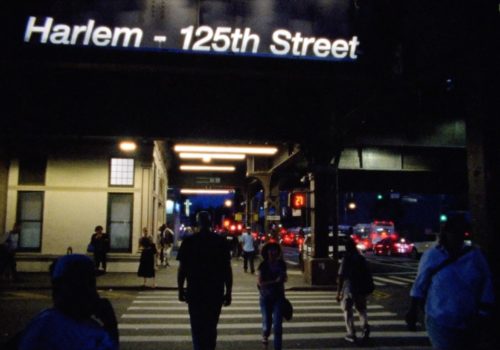Magnum photographer Khalik Allah‘s latest film, IWOW: I Walk on Water, is a concrete portrait of East Harlem. The artist’s longtime muse Frenchie’s, the face of a schizophrenic and homeless Haitian, the equally anonymous faces of Harlem nights are intertwined with the artist’s confidences. The result is a long and powerful poem combining pictures and snatches of discussion by Allah.
Khalik Allah joined Magnum Agency this year and his glaze, his photographs extends the spectrum of the agency. Allah marks a continuity and a rupture with photographers composing Magnum. Photographer Eli Reed, the first African-American to join Magnum Photos in the 1980s, was one of the main reason of his arrival at the agency. The poetic side of his work and his entirely subjective approach would make him singular while looking at the photojournalistic side of the agency. However, this same approach defining an invested photography with its subject, returning to the same places, weaving project after project the memory of individuals, brings him closer to atypical photographers like Bruce Gilden or Danny Lyon (who was not a full member of Magnum). The enthusiasm, the fascination for a neighborhood that never ceases to be photographed from every angle also evokes the work of his contemporary Devin Allen, known for his series A Beautiful Ghetto. Both of them contribute to showing neighborhoods inhabited by poverty, difficult lives, or just misery through the prism of poetry. Their cities are simply an integral part of their lives, and therefore, of their photographs.
Allah shot I Walk on Water with a simple idea: “My objective hasn’t changed, it’s always been to keep it real with myself; to stay true to my vision and to have the courage to express it cinematically“. The filmed images are supported by a narrative made up of different fragments of his thoughts. He tells a turbulent love relationship, discusses spirituality and mortality on the advice of Fab 5 Freddy (a member of the Wu-Tang Clan) or photographer Jamel Shabazz, and even includes intimate exchanges with his own mother.
Allah’s direct approach with his subjects brings to the surface many times conflicts, violence and brutality inherent in the street ecosystem. His portraits can be read as testimonies of the harshness of the existence lived by his subjects. Allah affirms that “a person’s face is a landscape,” and this landscape is taken head-on, without being disturbing, voyeuristic, or even spectacular (a flaw often blamed on photojournalism or documentary photography). His work happens to be balanced, while not cheating with the anguishing character, the distress experienced by all the characters. In this, Khalik Allah’s film has a dual character: it is both a documentary poem about the Harlem streets (“a statement […] of an uncompromising dedication to the streets”), as well as a first-person confrontation with himself. It intertwines street photography with the author’s haunting, leaping thought.
















